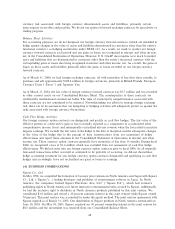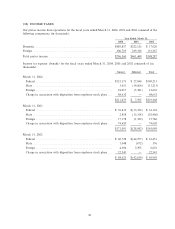Electronic Arts 2004 Annual Report Download - page 91
Download and view the complete annual report
Please find page 91 of the 2004 Electronic Arts annual report below. You can navigate through the pages in the report by either clicking on the pages listed below, or by using the keyword search tool below to find specific information within the annual report.The Prior Agreement required that AOL pay us 50 percent of all revenue collected by AOL from the sale of
advertisements on our online games sites, until advertising revenue reached $16.0 million in a year (measured
from October 1 through the following September 30). Thereafter, the Prior Agreement provided that AOL
would pay us 70 percent of all advertising revenue collected by AOL from the sale of advertisements on our
game sites. Under the New Agreement, AOL is entitled to retain all advertising revenue they collect from the
sale of advertisements on our games sites on the AOL properties, until net advertising revenue reaches
$20.0 million in the twelve months ended March 31, 2004, and until net advertising revenue reaches
$35.0 million for the remainder of the term of the New Agreement. After advertising revenue exceeds these
thresholds, AOL is required to pay us 50 percent of the additional net advertising revenue. These thresholds
were not met during Ñscal 2004 and accordingly, we did not record additional net revenue.
Other Fee Arrangements
Under the Prior Agreement, we were also required to pay AOL a percentage of our subscription, e-commerce
and anchor tenancy revenue that exceeded certain amounts. These costs were expensed as incurred and were
classiÑed as ""Cost of goods sold'' in our Consolidated Statements of Operations. We do not net these costs
against revenue because we maintain responsibility for providing e-commerce products and subscription
services directly to the consumer and retain the primary inventory risk for our products and games service.
Under the New Agreement, we are required to pay AOL a percentage of revenue derived from game service
subscriptions, e-commerce, downloadable games and prize games that we makes available on the AOL online
services. We account for these amounts in a similar manner as described above.
(8) ROYALTIES AND LICENSES
Our royalty expenses consist of payments to (1) co-publishing and/or distribution aÇliates, (2) content
licensors, and (3) independent software developers. Co-publishing and distribution royalties are payments
made to third parties for delivery of product. License royalties consist of payments made to celebrities,
professional sports organizations, movie studios and other organizations for our use of their trademark,
copyright, personal publicity rights, content and/or other intellectual property. Royalty payments to
independent software developers are payments for the development of intellectual property related to our
games.
Royalty-based payments made to content licensors and distribution aÇliates that are paid in advance are
generally capitalized as prepaid royalties and expensed to cost of goods sold at the greater of the contractual or
eÅective royalty rate based on net product sales. With regard to payments made to independent software
developers and co-publishing aÇliates, we are generally subject to development risk prior to the general
release of the product. Accordingly, payments that are due prior to completion of the product are generally
expensed as research and development as the services are incurred. Payments due after completion of the
product (primarily royalty-based in nature) are generally expensed as cost of goods sold at the higher of the
contractual or eÅective royalty rate based on net product sales.
Each quarter, we also evaluate the future realization of any prepaid royalties as well as minimum
commitments not yet paid to determine amounts we deem unlikely to be realized through product sales. Any
impairments determined before the launch of a product are charged to research and development expense.
Impairments determined post-launch are charged to cost of goods sold. In either case, we rely on estimated
revenue to evaluate the future realization of prepaid royalties. If actual revenue, or revised sales estimates, fall
below the initial sales estimate, then the actual charge taken may be greater in any given quarter than
anticipated.
76
























